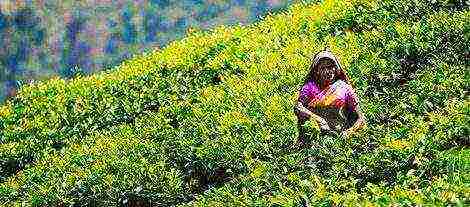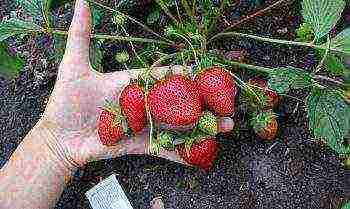Content [show]

Many gardeners choose Dutch varieties of tomatoes for planting, or rather hybrids. And all due to the fact that their yield and disease resistance are much higher than that of most domestic varieties.
This page contains the best Dutch varieties of tomatoes for greenhouses and open ground, undersized and tall, early and mid-season, with fruits of various colors and tastes.
The disadvantage of Dutch hybrids is that for the most part they lose to varieties in taste, especially if they did not ripen on a bush. They are mainly grown for their excellent yield, disease resistance and good marketability.
Click on the hybrid you like - a page will open with a photo and description of this tomato, as well as reviews of gardeners from different regions about it.
If you have grown any of these hybrids, please leave your feedback to them.
We hope that our catalog will help you find the best Dutch tomato hybrids for planting.
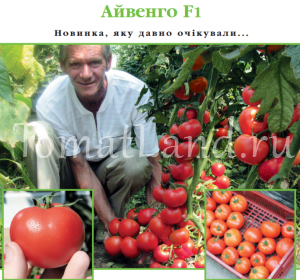 Tomato Ivanhoe
Tomato Ivanhoe
Mid-season, indeterminate, tomato hybrid from Dutch breeders. Recommended for cultivation in film greenhouse structures: for use in two short and extended cultivars ...
TomatLand2 100 views1 comment
Afen tomato
Early maturing (95-100 days from germination to maturity), indeterminate, high-yielding tomato hybrid for greenhouses. The plant is tall, with short internodes, requires a garter to support and a stepson ...
TomatLand1 810 views3 comments
 Tomato Bella
Tomato Bella
Mid-early (107-115 days from germination to maturity), tall, carpal tomato hybrid from Dutch breeders. Recommended for growing in greenhouses. The plant is indeterminan ...
TomatLand1 428 views0 comments
Benito tomato
Mid-early (95-113 days from germination to maturity), determinant, undersized, high-yielding Dutch tomato hybrid for open ground and film shelters. The bush is 50-70 cm high, not ...
TomatLand2 746 views2 Comments
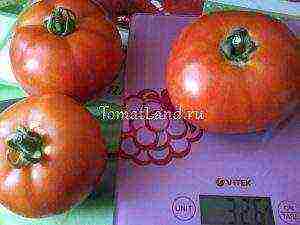 Berberana tomato
Berberana tomato
An early, indeterminate, very productive hybrid of a Dutch breeding tomato. The bush is tall, with a regular leaf. The tomatoes are round, slightly flattened, dense. The color of the ripe fruit is nasa ...
TomatLand4 308 views4 Comments
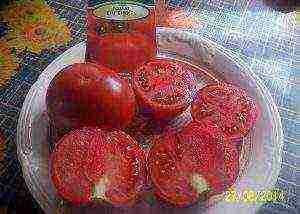 Tomato Big Beef
Tomato Big Beef
Early maturing, indeterminate (unlimited growth), Dutch hybrid for greenhouses. The period from germination to maturation is 99-105 days. The bush is powerful, densely leafy, spreading, ...
TomatLand4 646 views12 comments
 Tomato Bobcat
Tomato Bobcat
Medium early, determinant, productive Dutch tomato hybrid. Recommended for growing in open ground, under temporary film shelters, in greenhouses. The bush is powerful, well leafy ...
TomatLand5 042 views5 comments
Tomato Debut
An early, determinant, productive Dutch tomato hybrid. Recommended for growing in open ground and film shelters. The bush is medium-sized, well leafy, requires a garter to ...
TomatLand1 751 views1 comment
Tomato Diadem
An early ripe, determinant hybrid of a Dutch breeding tomato for open ground and film shelters.Requires the formation of a plant in 1 or 2 stems. The first inflorescence is laid over the 7th leaf, p ...
TomatLand1 522 views1 comment
Tomato Donald
Early (80-95 days from germination to maturity), determinant, undersized carpal hybrid of tomato for open ground. Bush up to 50 cm high, does not require pinching. Rounded fruits, moat ...
TomatLand2 055 views1 comment
Tomato Zhenaros
Mid-early, indeterminate, tall Dutch hybrid of tomato for greenhouses. The bush is medium-leafy, medium-sized. The manufacturer recommends forming it into 1 stem, removing all lateral ...
TomatLand573 views3 comments
 Tomato Classic
Tomato Classic
Early maturing (95-105 days from germination to maturity), determinant, productive hybrid of tomato for open ground from Dutch breeders. Has good fruit setting at high rates ...
TomatLand1 278 views0 comments
Tomato Corleone
Mid-season, indeterminate, high-yielding, carpal Dutch tomato hybrid. Recommended for growing in greenhouses. The bush is powerful, tall, requires a garter to support and pinching. NS…
TomatLand984 views0 comments
Tomato Lemon Boy
An early, indeterminate, high-yielding, bristle, Dutch hybrid of a tomato for greenhouses. The height of the bush is up to 2 meters, a garter to the support and pinching is required. The manufacturer recommends to form ...
TomatLand694 views0 comments
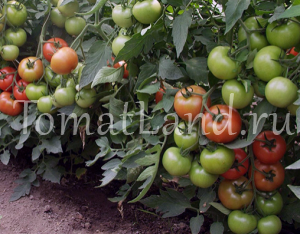 Tomato Magnus
Tomato Magnus
Early maturing (95 days from germination to maturity), semi-determinant, high-yielding tomato hybrid from Dutch breeders. Recommended for growing in greenhouses. A bush of dense leaves ...
TomatLand1 586 views1 comment
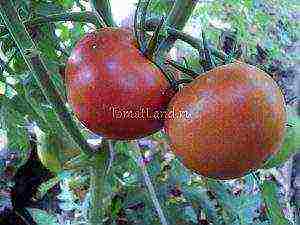 Tomato Martha
Tomato Martha
Mid-season, indeterminate (unlimited growth), productive tomato hybrid. Recommended for growing in greenhouses in the middle lane and in the open field in the southern regions with an obligation ...
TomatLand2 481 views2 comments
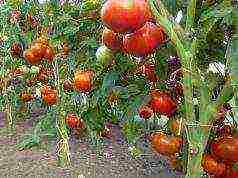
Tomato, aka tomato, is one of the most consumed vegetables in the world. It benefits the body both internally and externally. This healthy crop is used as a stand-alone product, for making sauces or tomato pastes, and even as an ingredient in cosmetics. Among the most popular foreign varieties, a special place is occupied by breeding hybrids from Holland. Despite the harsh natural conditions, resistant varieties of tomatoes have been developed in this country. They are distinguished by their good and natural taste, resistance to diseases and bad weather conditions, and they also bring a rich harvest.
Features of seeds
Tomatoes bred in a particular country have distinctive characteristics. Most often this is due to the natural conditions of the places where they were bred. Dutch breeding seeds are distinguished by three characteristics:
- Relatively low cost of tomato care. Because these varieties are very unpretentious, but very fertile.
- Increased resistance to diseases and pests. Hybrids are able to ignore most plant diseases.
- High productivity per square meter. Specialists are able to get 2 times more fruits than from traditional types of tomatoes.
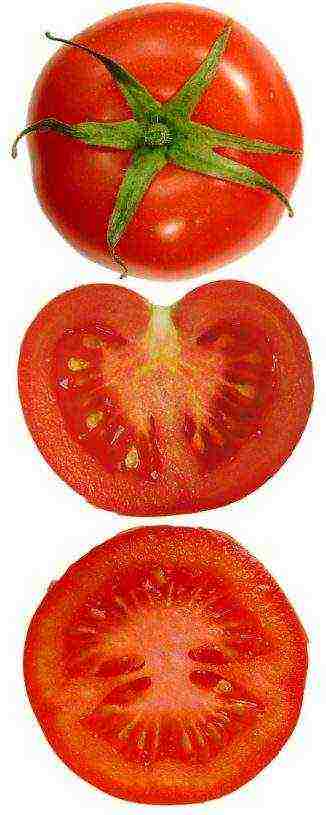 Tomato is one of the most popular crops due to its valuable nutritional and dietary qualities, a wide variety of varieties, and high responsiveness to the growing methods used.
Tomato is one of the most popular crops due to its valuable nutritional and dietary qualities, a wide variety of varieties, and high responsiveness to the growing methods used.
Varieties are distinguished on several grounds. There are types for growing outdoors and for closed soil (under film or in greenhouses).
Open ground varieties
An early hybrid of a Dutch tomato with a high yielding capacity. It has a very short ripening period and a long fruiting period. The time from the moment of planting for seedlings to the receipt of the first ripe tomatoes is usually 88-92 days. The variety can be grown both on open ground and under a film. The color of the unripe fruit is light green, the ripe fruit is red. The weight of one fruit varies from 180 to 220 g. The maximum yield can be 9.1 kg per square meter... This variety does not respond to verticillium and fusarium wilting.
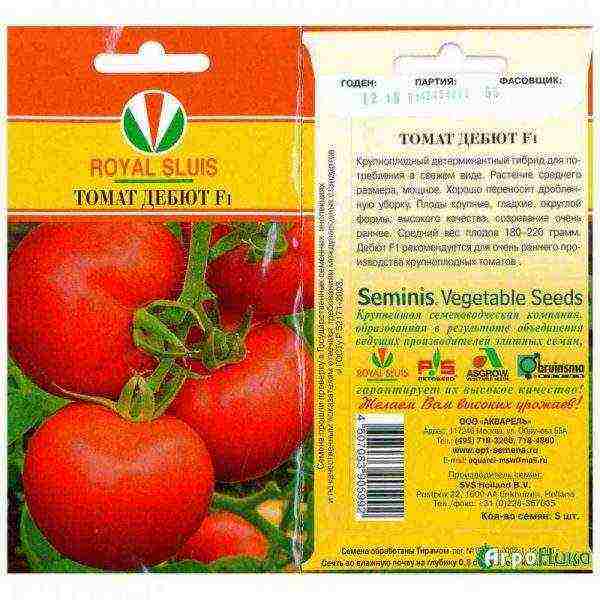 Tomato variety "Debut"
Tomato variety "Debut"
Sowing seeds for seedlings should be done 60 days before the start of planting in the ground. Usually seeds are treated with thiram and do not require soaking.
Sultan
A high-yielding tomato that can withstand the harsh natural conditions of the continental climate. Medium early appearance (95-110 days between planting of seedlings and ripening). The variety is powerful, undersized, the stems are well developed and do not require a garter. The fruits are large and fleshy, weighing about 150-200 g of a rich red hue. They have good taste. The yield can increase up to 15 kg from 1 sq.m. with proper care.
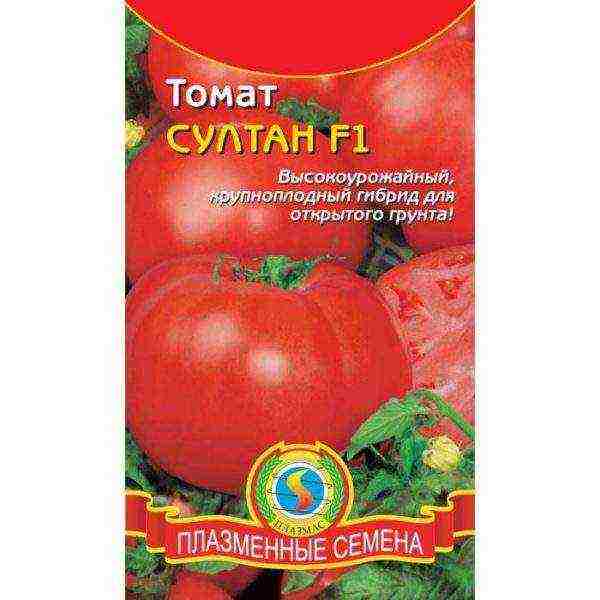 Tomato variety "Sultan" Tarpan
Tomato variety "Sultan" Tarpan
The variety is medium early (98-105 days), heat-resistant and large-fruited. Can be grown outdoors and under a film covering. The bush is medium in size and compact. Fruits are dense and juicy, have a special taste characteristic of pink tomatoes. The mass of an average tomato outdoors reaches 130-160 g, in greenhouse conditions 160-180 g. Ripe fruits have a beautiful pink color (with mother-of-pearl). The variety is not prone to cracking. The harvest brings up to 6 kg per sq.m.
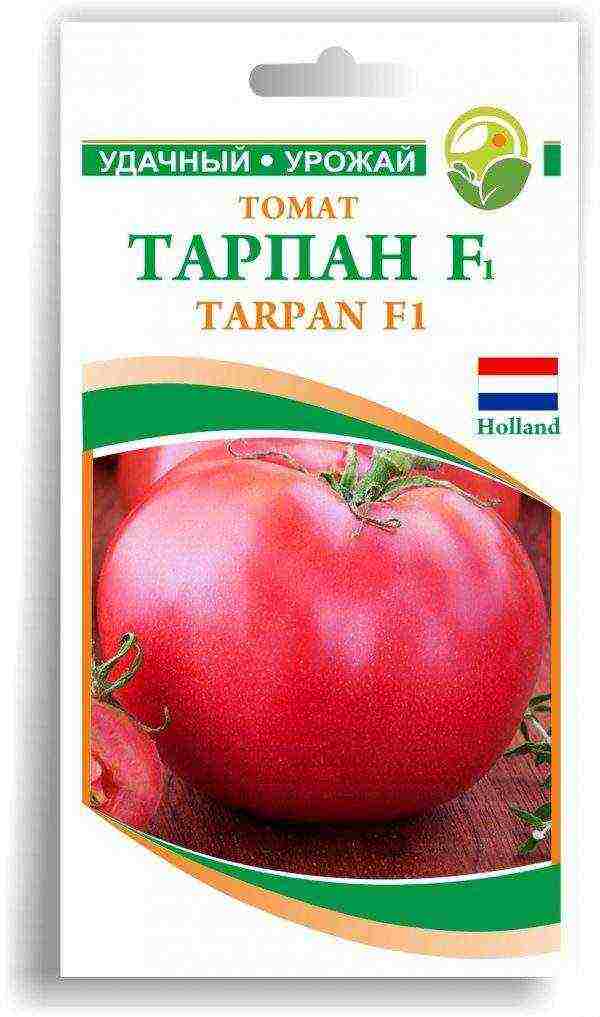 Tomato variety "Tarpan"
Tomato variety "Tarpan"
This species can be grown with thickening - up to 5 seedlings per 1 sq. M. Fertility grows by 90%, and the size of tomatoes remains practically unchanged.
Tanya
A medium early type of tomato (107-110 days), used for open ground and greenhouses. The bush is powerful, compact and heat resistant. It does not require additional shaping, which greatly facilitates its care. Fruits are firm, red in color and high in sugar. The variety is lightweight and not prone to cracking. Resistant to diseases such as alternative stem cancer, gray leaf spot, verticillium wilt. The yield allows you to collect up to 3 kg from 1 sq. M. with proper care.
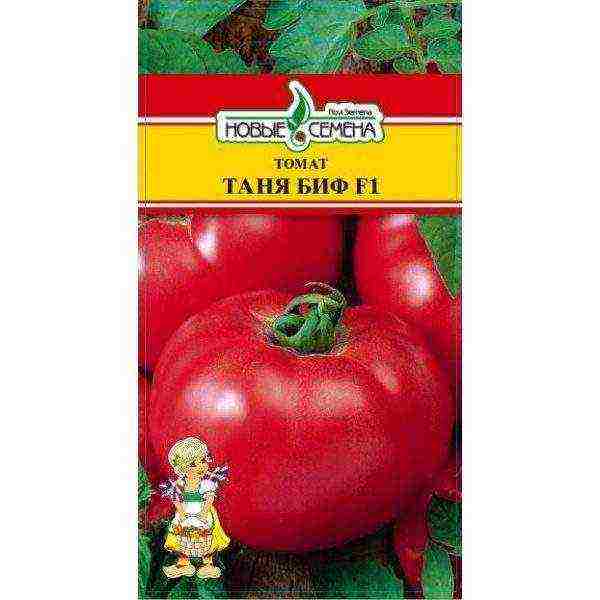 Tomato variety "Tanya" Super Red
Tomato variety "Tanya" Super Red
Early ripening high-yielding variety (65-70 days). The bush is powerful but compact and requires garter and shaping. The average fruit weight is 160-200 g with a uniform bright red color. Great for hot growing conditions. Resistant to fusarium and verticillary wilting, tomato mosaic viruses and yellow curly leaves of tomato. Has a high yield potential.
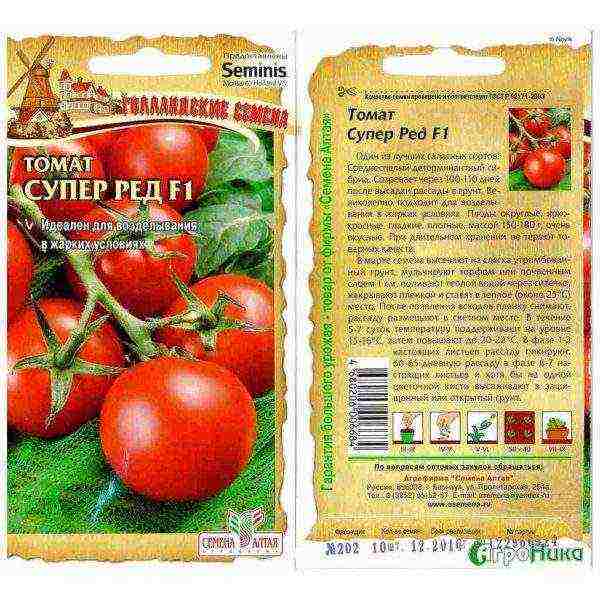 Tomato variety "Super Red" Polfast
Tomato variety "Super Red" Polfast
Early type of tomato (86-91 days). Low-growing and high-yielding. Fleshy fruits of bright red hue weighing up to 150 g. Do not crack during storage and have a good taste. The harvest can reach 6.2 kg per sq.m. The variety is not susceptible to fusarium and verticillosis. Due to early maturation, it is not affected by late blight.
 Tomato variety "Polfast"
Tomato variety "Polfast"
Differs in good tie at low temperatures. As a result, it is suitable for growing on open soil in the middle climatic zone.
Greenhouse varieties
When the “F1” mark is present in the name of tomatoes, this indicates that this is not a variety, but a tomato hybrid.
Krystal F1
Early (about 90 days before ripening), carpal tomato hybrid. Possesses increased stamina and vigor of growth. The plant is tall, with dense foliage, which growers recommend to remove, forming a plant in 1 stem. Fruits are dense, fleshy, deep red with an average weight of 130-150 g. Each tomato has three chambers and has a pleasant taste. The variety does not respond to diseases such as verticillium, cladosporium and tobacco mosaic virus. The yield on open soil reaches 8 kg, in the greenhouse - 12.7 kg.
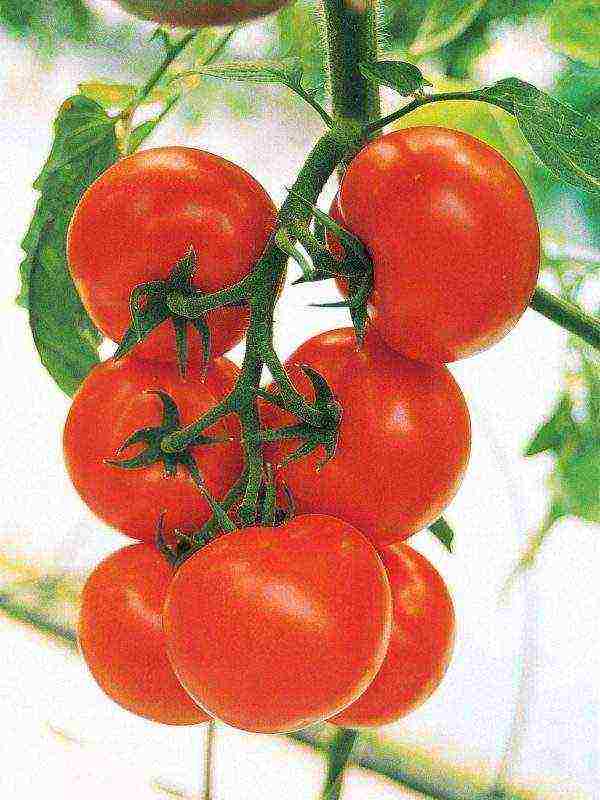 Tomato variety "Crystal F1" Bobcat F1
Tomato variety "Crystal F1" Bobcat F1
Greenhouse hybrid of late ripeness (about 97 days). Fruits are large, fleshy, red, weighing 150-250 g. They have a pleasant sour taste. Not susceptible to stemfiliosis, verticillosis, alternaria and fusarium wilt. Productivity up to 5 kg from 1 sq.m. with good processing. The variety is excellently preserved and transported over long distances.
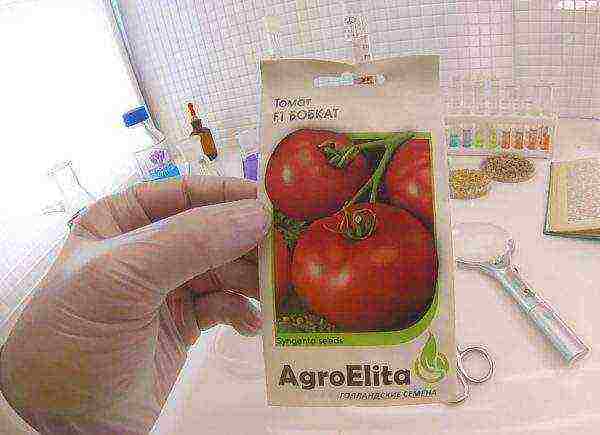 Tomato variety "Bobkat F1"
Tomato variety "Bobkat F1"
Most often, this type is used in the manufacture of tomato sauces and pasta.
Skif F1
Early tomato (90-103 days) for greenhouses and open ground. Requires a garter and the formation of a bush in two or three stems. Fruits of medium density, fleshy, red with a weight of 140-200 g. Good tomato flavor (for a hybrid). The variety is resistant to high temperatures, fusarium, verticillium, tobacco mosaic virus, fusarium, nematode. Harvest up to 5.8 kg / sq.m.
 Tomato variety "Skif F1"
Tomato variety "Skif F1"
Bushes can be planted in a compact way, 6-7 pieces per 1 sq. M. Due to its excellent quality and high yield, the variety can be used on an industrial scale.
F1 President
An early and high-yielding hybrid, one of the five best tomatoes for growing in the middle climatic zone... The bush requires a garter and care. It is recommended to leave 1-2 stems. With proper care, you can get a good harvest. Fruits are dense, bright red, weighing about 200 g. The yield can increase up to 8 kg from 1 bush with appropriate processing and drip irrigation. The variety is resistant to late blight, Alternaria and other diseases of tomatoes.
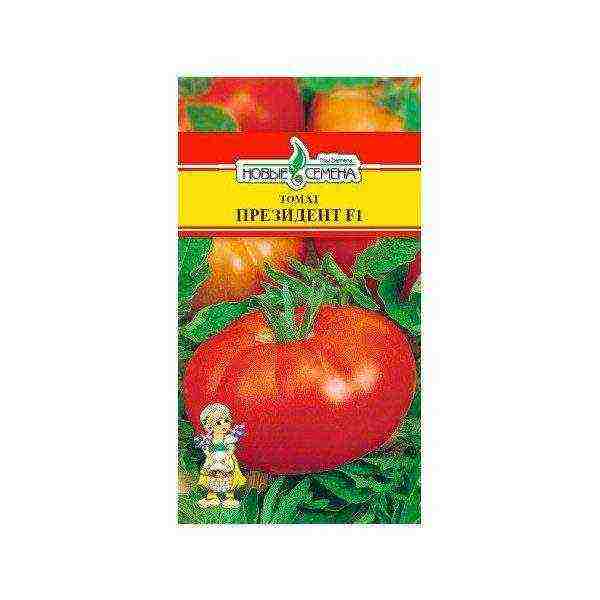 Tomato variety "President F1"
Tomato variety "President F1"
The variety does not tolerate a number of diseases, therefore it is easily suitable even for growing in a greenhouse with chronically infected soil.
Beef F1
Medium early variety (110 days) for greenhouses and open planting. Fruits are large, fleshy, weighing up to 300 g with a characteristic tomato flavor. The tomato is resistant to verticillary wilting, nematode, gray spot, tobacco mosaic virus. Other large-fruited tomato varieties are presented in this article.
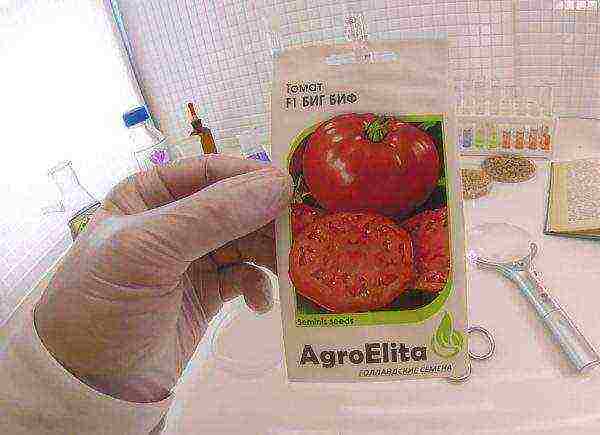 Tomato variety "Beef F1"
Tomato variety "Beef F1"
The variety of Beef-tomatoes has some differences when leaving - a rare planting (a large distance between the bushes), more intensive feeding, formation in 1 stem.
Pink Paradise F1
Medium ripeness tomatoes (about 3 months). The variety is recommended for indoor cultivation. Plants require garters and pinching (growers advise leaving one stem). Fruits are of medium density, pink in color, about 200 g. They have a rich sweet taste. The species is resistant to nematodes, verticillium wilt, tobacco mosaic and cladosporium disease. The yield rises to 5 kg from 1 bush with constant care.
Video
conclusions
Agricultural products require painstaking and constant attention. However, there are varieties and species that are able to "work" without tireless care. One of these plants is the Dutch tomato varieties. Due to their historical homeland, they are stable and unpretentious to care for. At the same time, almost all varieties give huge yields. The main thing is to find the right look. Tomato is a very tasty and healthy vegetable, and with the variety of its varieties, you can always find your “favorite”.
Today, Dutch varieties of tomatoes are well known throughout Russia and abroad, for example, in Ukraine and Moldova, where they are successfully grown. Some well-known varieties and hybrids are in the top twenty of the most popular due to their resistance, vigor, high yield. Let's talk in more detail about how they differ from domestic varieties, what is their popularity, and present to our readers the best Dutch tomatoes that may be on your table.
Features of varietal tomatoes from the Netherlands
Nowadays, on store shelves you can find many varieties and hybrids of tomatoes from various manufacturers. A fairly large market share belongs to companies from the Netherlands, for example, Nunhems, Seminis, Syngenta, Bejo. They are undoubtedly the leaders among imported seeds.
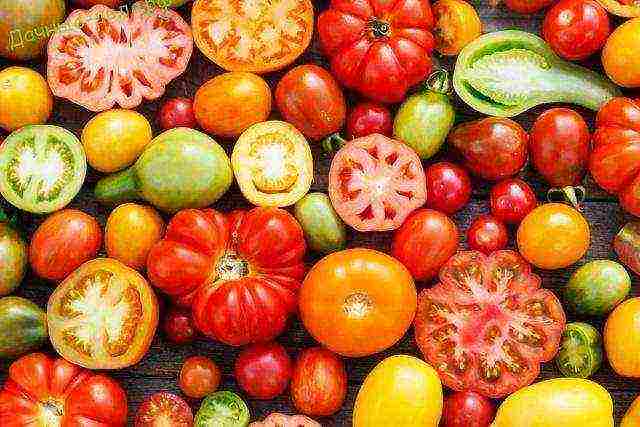
As an edible crop, tomatoes were not used in Europe until the 18th century, although they were imported from America two and a half centuries before that.As for the Netherlands, despite the heat-loving culture, it quickly took root in this country. Very often it is for this reason that our gardeners choose exactly the Dutch varieties of tomatoes. The Netherlands is a country with a minimum number of sunny days a year, it rains very often there, so when crossing, breeders try to breed varieties and hybrids that are resistant to such conditions.
Among Dutch tomatoes, there are both those that can be grown in greenhouses and those that are intended for outdoor use. However, one should not delude ourselves: for each specific hybrid or variety, it is necessary to withstand the conditions for which it was bred. Disease resistance is a huge advantage, but many domestic tomatoes tolerate most diseases and viruses well, which makes them equally popular.
Important! When choosing seeds, pay attention to the information on the package.
For someone, the ripening period, taste are important, but for someone the safety of tomatoes, the ability to transport them, or even such quality as the height of the bush and the complexity of caring for the plant are considered more important.
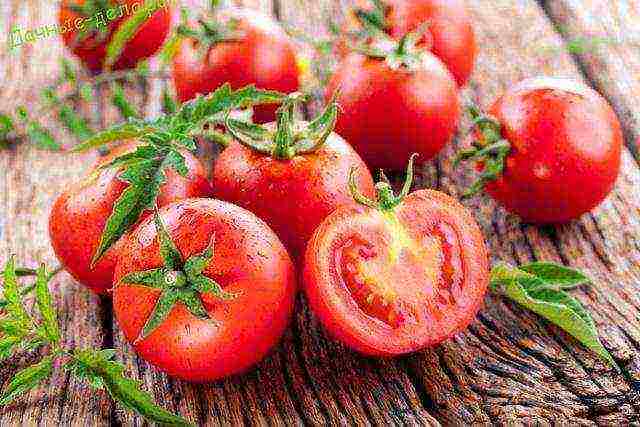
If you buy seeds of hybrids or varieties in a store, pay attention to the fact that the information on the package is translated into Russian. Important information:
- tomato resistance to disease;
- ripening period of tomatoes;
- plant and fruit size;
- yield per bush or square meter;
- use and taste.
Since the competition in the market today is great, new greenhouse farms are being built every year, experts advise from time to time to try new selection, including imported tomatoes.
Review of the best varieties of tomatoes
Consider the most popular Dutch selection tomatoes in Russia today. They are found on the shelves of most gardening stores. Some gardeners generally do not pay attention to them, believing that imported products are not suitable for growing in our conditions. This statement is incorrect.
Below is a brief table of the main parameters, which is very convenient to navigate. A detailed description of these hybrids and varieties is given below.
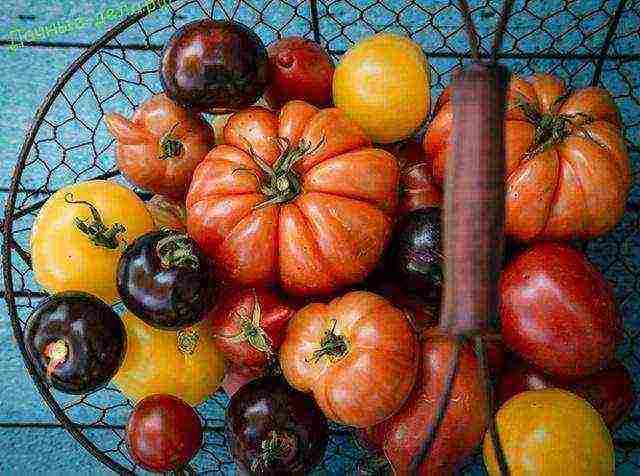
table
Name of variety / hybrid Maturing term, in days Type of growth of tomato bush Fruit size, in grams Yield, in kilograms per square meter Bobcat F1 President F1 Shakira F1Polbig F1Rio GrandeBig Beef F1Crystal F1Skyth F1Jaguar F1
| late, 130 | determinant | up to 225 | maximum 6.2 |
| early, 68-73 | indeterminate | 200-250 | 15-21 |
| early maturing | indeterminate | 220-250 | 12,7 |
| medium early, 90-100 | determinant | 180-200 | 5,7 |
| late ripening, 120-130 | determinant | 70-150 | 4,5 |
| early, 73 | indeterminate | up to 330 | 10-12,4 |
| mid-season, 100-120 | determinant | 130-150 | up to 12.7 |
| medium early, 90-103 | determinant | 150-220 | 12-16 |
| early ripe, 73 | determinant | up to 180 | 10-12,4 |
Important! If the name of the tomato contains the F1 mark, this means that this is a hybrid, not a variety.
It is distinguished by high vigor, but it will not work to collect seeds from such tomatoes for further cultivation.
Bobcat
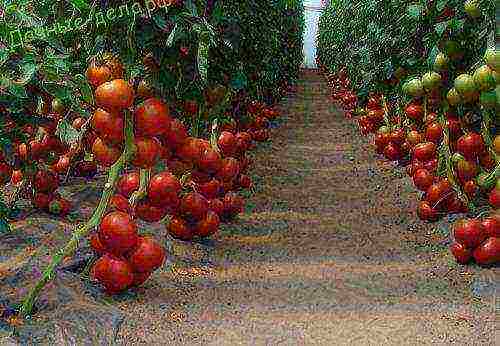
Late-ripening hybrid "Bobkat" is intended for growing in open and protected ground. It is most commonly grown for making tomato pastes and sauces. Tomatoes are fleshy, red in color with good taste. They are well stored, transported over long distances, the preservation is 10 days. A hybrid resistant to verticillium and fusarium.
The president
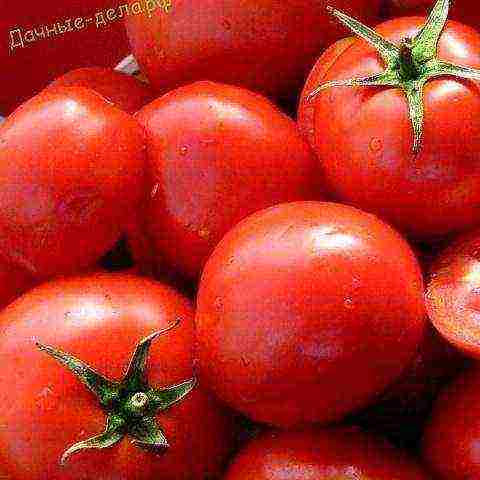
The Dutch hybrid "President" is one of the five best varietal tomatoes for cultivation in Russia. This is no coincidence. It is successfully grown both outdoors and in greenhouses. It is resistant to a whole range of diseases, so it is appropriate to acquire it with chronically infected soil in greenhouses and film shelters.
The tomato bush requires care: pinching, shaping. If done correctly, the yield will be very high. Another plus of the hybrid is the excellent taste of tomatoes.Every breeder dreams of breeding such a delicious tomato. The skin of the fruit is dense, which prevents cracking. You can sell such a product as a top-class product.
Shakira
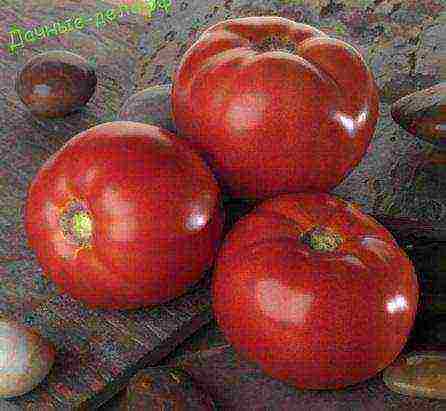
One of the novelties of the Russian market. The new hybrid is represented by fleshy tomatoes with excellent taste. The skin is firm, the tomatoes do not crack. It is imperative to form a plant and pinch it.
Attention! Experts advise growing a two-stem hybrid.
It is necessary to sow tomato seeds in early March, while they do not need soaking and disinfection. They sprout together, each bush reaches one and a half meters.
Polbig
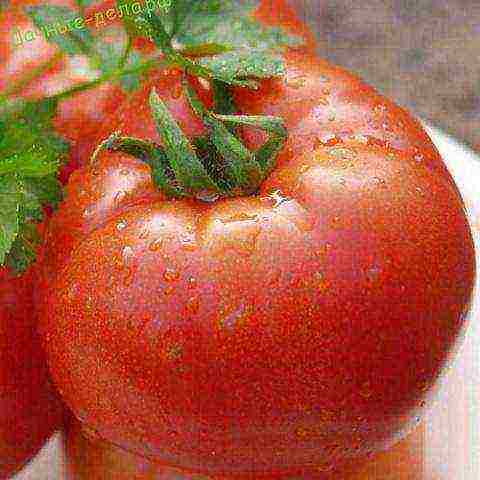
Hybrid "Polbig" is represented by early ripe tomatoes with excellent taste. It grows well both in open sunny areas and in greenhouses. The bush is determinate, of limited growth, so caring for the plant is not very difficult. Three months after the appearance of the first shoots, you can count on a rich harvest.
A tomato hybrid is resistant to fusarium and verticilliosis. The fruits do not crack, are perfectly transported, have an excellent presentation. The use of tomatoes is possible both fresh, in salads, and for canning.
Rio grande
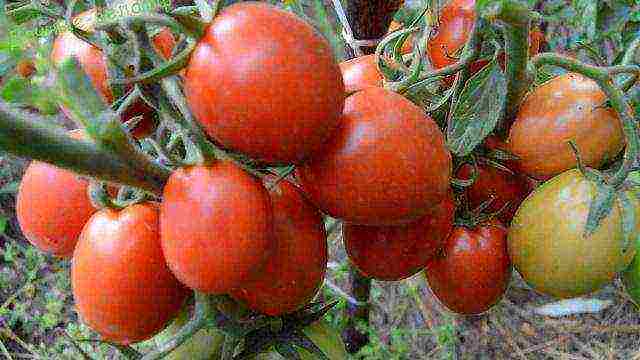
Describing the best varieties of tomatoes, one cannot but recall the Rio Grande. This versatile variety is represented by small oval red tomatoes. He is somewhat afraid of significant temperature fluctuations, so the greatest success in yields can be achieved by planting seeds in the southern regions. The germination rate there is so high that you can sow tomatoes directly into open ground, without using the seedling method. The "Rio Grande" variety can also be grown in film shelters.
The tomato variety is resistant to major diseases, ripens for a long time, but the taste will not leave anyone indifferent. Tomatoes do not crack, they can be transported and stored for a long time due to their dense skin. The use is universal. Conservation of this variety is convenient, since the size of the tomato fruit is small.
A good video about this tomato variety:
Big Beef
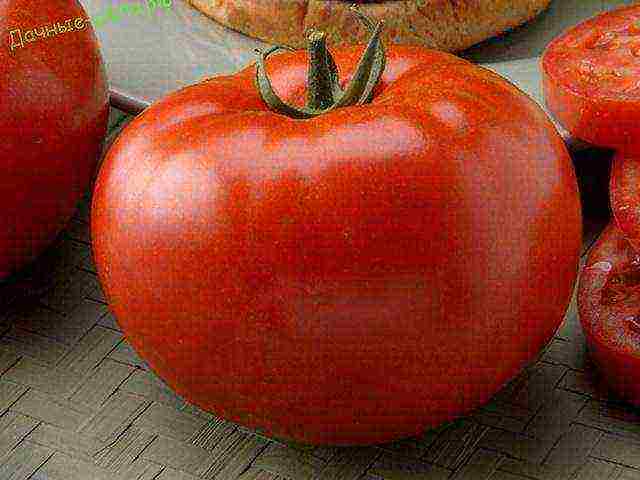
Many Russian gardeners are familiar with the Big Beef tomato hybrid that Holland gave us. It is early ripe, ripens in just 73 days, while the yield is extremely high. The bush is of an indeterminate type of growth, tall, it must be pinned and tied up. Since it is quite sprawling, you should not plant more than 4 bushes of tomato seedlings per square meter.
Tomato fruits are bright red in color, the very term "beef" in the name speaks of the fleshiness of the fruit. Good taste, versatile use. The hybrid has achieved particular popularity due to the fact that it is resistant to most dangerous diseases and viruses, including fusarium, verticillosis, nematode, alternaria, TMV, gray leaf spot. Can be grown for soil problems.
Krystal
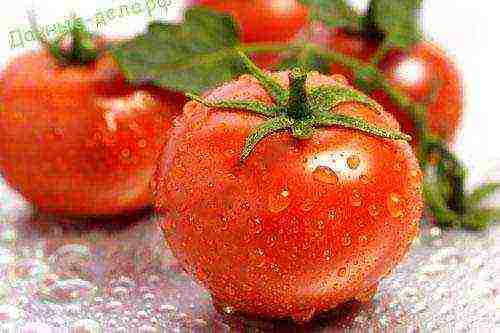
A very resistant tomato hybrid with high vigor. Tomatoes are dense and crack-resistant. Since the bush is indeterminate, its growth is unlimited. Moreover, the bush itself is not very high. When leaving, you will need to tie up and pinch the plant. Designed for growing both outdoors and indoors.
The Kristal hybrid is resistant to cladospirosis as well. The fruits of this variety are medium in size, have good taste, are used mainly for salads and fresh. Some summer residents believe that this particular tomato hybrid has a pleasant taste, but there is not enough sweetness in it. As you know, there are no comrades in taste and color.
Scythian
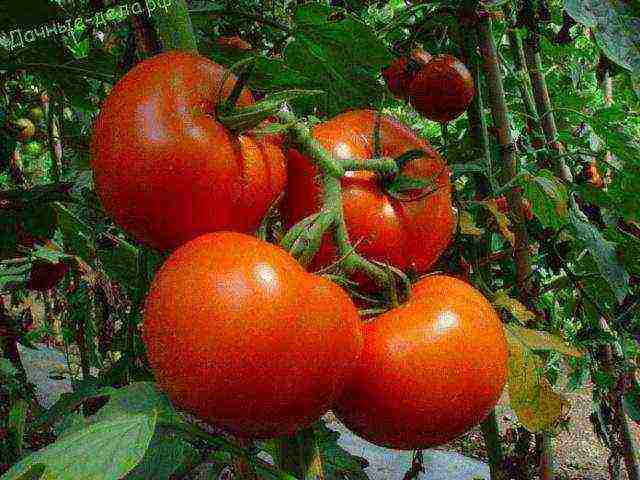
Skif tomato hybrid, good for a whole range of qualities, is well known to Russian summer residents. It is intended for cultivation both in the open and in the closed ground. The tomato is resistant to nematodes, verticilliasis and fusarium.
Despite the fact that tomatoes have a pleasant aroma and excellent taste, they are used mainly for salads and fresh. The bush is compact, seedlings can be planted compactly, 6-7 pieces per square meter. Tomatoes are of excellent commercial quality, with high yields, they can be grown on an industrial scale. Professionals collect at least 5 kilograms of excellent tomatoes from one bush.
Jaguar

The jaguar is a hardy tomato hybrid with a short growing season. In just 73 days from the moment the first shoots emerge, a rich crop of the highest quality can be harvested. The main advantage is high growth force and resistance to a large number of diseases: nematode, verticillosis, TMV, fusarium. Due to the fact that the hybrid ripens very quickly, it is not afraid of late blight.
You can use the fruits of a tomato as you like: they are tasty, pickled and salted, used for processing and juices. The commercial qualities of the hybrid are also high.
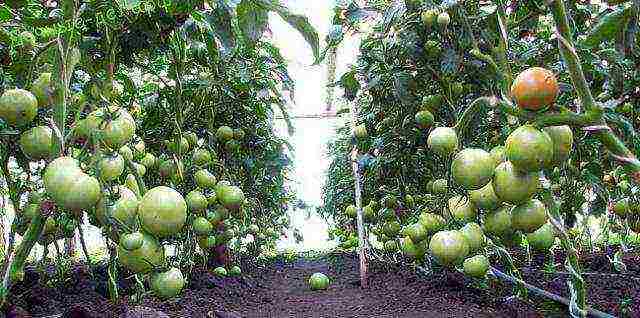
In order to finally understand the question of whether Dutch tomato seeds are good, you need to consider the reviews of those summer residents who have grown them more than once.
Reviews of gardeners about varieties and hybrids from Holland
Dutch tomato varieties are distinguished by their high resistance to diseases. Our brief review pointed out this fact. That is why they are often preferred by greenhouse owners. Soil cultivation in plastic and glass greenhouses is a big problem. When grown, tomatoes are often alternated with cucumbers to avoid contamination.
Maria Andreeva, Moscow region
I love the hybrid "President" of the Dutch selection, it gives an excellent rich harvest, which suits me completely. Also several times were planted "Bull's Heart" from Holland of various colors, pink and even black varieties. Delicious, large, but they can only be used for salads. It makes no sense to preserve them.
Olesya V, Crimean Peninsula
I have been growing tomato seeds from Holland for ten years in the open field. I love "Rio Grande" very much, they are small and tasty, they make excellent salads. Of the unusual, I took up the cultivation of a hybrid "Benito", it seemed that the usual "Rio Grande" is better. We also planted "Rosaliza", it has beautiful pink fruits, low compact bushes. The Dutch tomato varieties are really very hardy. If you plant ten seeds, in the worst case, 8-9 will germinate, and in the best case, absolutely everything. For this we love them.
Valery Kim, Volgograd
I have three greenhouses on the site, in one of them I always plant the President and Big Beef tomatoes. I like Dutch varieties for two reasons: they grow very well, they are not afraid of any diseases, their firmness is excellent, plus excellent commercial qualities. Since I sell 70 percent of the harvest, this is very important for me. Tomato fruits are well stored, do not crack, have a beautiful skin tone and a pleasant shine. This is not to say that they are tasteless, on the contrary, the very aroma of a tomato is present, there is enough acidity and sweetness. I advise you to buy seeds only in specialized stores in good packaging, and not from your hands on the market.
Conclusion
Of course, tomato seeds from Holland are widespread throughout the country today and are very popular. This is due to the fact that agricultural companies from this country work for the Russian market, while having vast experience in the field of breeding. Try to comply with the growing conditions, and the harvest will be delightful!
Source
The Dutch have succeeded not only in growing tulips, but have recently gained popularity in the tomato market as the best in the breeding of this vegetable in the world. They have developed varieties of tomatoes that are both high-yielding and resistant to various diseases characteristic of this delicate vegetable.
The history of the emergence and cultivation of tomatoes in Holland
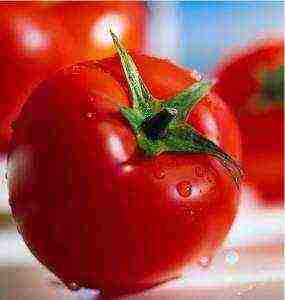
Many people know that tomatoes came to Europe from the American colonies after Columbus's famous discovery of new lands.
Many people know that tomatoes came to Europe from the American colonies after the famous discovery of new lands by Columbus. The correct name of the vegetable - tomato - originates from the language of the Aztecs, who so called not only this vegetable, but also the physalis close to it. And the Italians began to call it a tomato, which in translation means a golden apple, because the first fruits were yellow and glowed to match the paradise apples. If many Europeans considered tomatoes to be an ornamental plant, it was the Italians who first began to eat them, and then even taught this to the Americans.
In the middle of the 16th century, this outlandish plant appeared in the gardens of the Dutch, and only in the second half of the 18th century did it gain a foothold in the category of edible vegetable crops. And since then, thanks to crossing and selection, tomatoes have firmly conquered the north of Europe, they began to be grown in Holland and Sweden, where they easily adapted to the harsh climate conditions of these countries. And nowadays, hybrids of tall and medium-sized tomatoes from Holland have gained popularity among gardeners, because they have a real tomato taste and give a large harvest.
Characteristic properties of the best varieties of Dutch tomatoes
For gardeners, the main task is to choose the best variety that will successfully pass all stages of growth and give a large number of tomatoes from the bush.
The following hybrid tomato varieties from Holland are popular:
The early maturing large-fruited Bobcat F1 ripens for a hundred days both indoors and outdoors. The variety is not afraid of a sharp increase in temperature over 30 degrees Celsius, it easily tolerates this, and also has a high resistance to fungal diseases. The fleshy bright red fruits of the tomato can be stored for a long time and are not damaged during transportation.
The variety Crystal F1 grows even earlier, which is universal in purpose: tasty in salads, pleasant in winter preparations. Medium-sized three-chambered fleshy fruits have a high quality taste and retain it perfectly for a long time. The plant is resistant to diseases such as tobacco mosaic, verticilliosis and cladosporiosis. With proper care, up to seven kilograms of delicious fruits can be harvested from one bush.
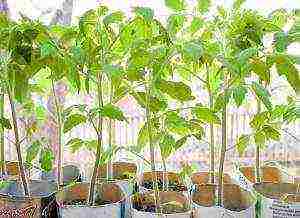
President II F1 is considered a particularly high-yielding, powerful Dutch variety
President II F1, which grows best in greenhouses, is considered a particularly high-yielding, powerful Dutch variety. Dense, slightly ribbed fruits reach a mass of at least three hundred grams. The variety has a high stable protection against diseases caused by various fungi and viruses.
Tomatoes of the Tarpan F1 variety are distinguished by their compactness and early ripening. Juicy pink fruits with a pleasant sweet taste are mainly suitable for preparing salads.
Skif F 1 is characterized by high growth, therefore, the main requirement for care is considered to be tying bushes to trellises, and early maturity. Tomatoes are not afraid of infection with fusarium, verticillosis and nematodes.
The Big Beef F1 variety results in a vigorous plant with a long stem with very large three hundred grams of fruits, which, unlike other hybrids, have a pronounced tomato flavor.
This Dutchman is comfortable in any conditions: both in equipped greenhouses and in the open field using stakes and trellises.
Similar to the Cherry variety, the Punto 7 F1 tomato amazes with its pleasant taste, is especially good for making ketchups, various types of sauces and salads, and is irreplaceable in canning.
The hybrid is not afraid of all known diseases that most often affect tomatoes.
The varieties Polfast and Polonez are the most ultra-early: they delight with fruits two months after planting.They have such an excellent quality as the characteristic good fruit set even at low temperatures.
The main characteristic of Dutch tomato hybrids is their ability to be resistant to diseases, most often affecting tomatoes, and to unfavorable climatic conditions.
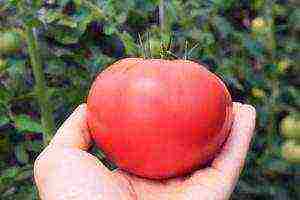
The main characteristic of Dutch tomato hybrids is their ability to be disease resistant.
Advantageous features of Dutch tomato cultivation technology
The main thing in growing any vegetable, including tomato, is to obtain a rich harvest with a minimum of physical and material costs for this. And Dutch breeders showed how to achieve this by developing a special technology for growing tomatoes.
In a small area, using bags filled with a nutrient substrate, more than sixty kilograms of tomatoes can be harvested from one square meter.
The soil base for growing vegetables is rock wool instead of earth, this leads to the fact that the risk of contamination of tomatoes with various diseases is reduced.
In the greenhouses according to the Dutch method, the cultivation of a delicious vegetable takes place all year round. A plant grown using Dutch technology must meet certain requirements. The peduncle of such tomatoes should be short with a cluster of flowers hanging down. On the first brush, the number of leaves should not exceed ten, and the stem of the vegetable should be of medium thickness with correctly located internodes.
It takes a lot of effort and patience to reap the fruits of the high-yielding, disease-resistant tomato varieties.
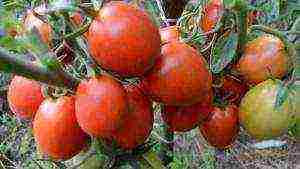
It takes a lot of effort and patience to produce fruits from high-yielding, disease-resistant tomato varieties.
The main secrets of growing tomatoes include:
- Remove diseased and damaged leaves from plants in time.
- To trim excess ovaries, otherwise the tomato will not have enough strength to grow all the fruits.
- For high-quality pollination, it is good to launch insects into the greenhouse: wasps, bumblebees.
- Take the harvest every morning. Cover the bushes with the last fruits with foil or coat the stems with ethylene, which will allow them to ripen faster.
- For better preservation, the crop is folded into boxes or baskets, laying their foam on the bottom.
After harvesting the fruits, the greenhouses are cleared of bushes, disinfected the soil or completely replaced and the seeds are re-planted.
Selecting a place and creating conditions for the successful growth of a tomato
An ideal place for growing Dutch tomato seedlings is a spacious greenhouse, which provides conditions for air temperature control and ventilation. Before planting plants or seedlings indoors, it must be heated to the desired level so that the soil constantly maintains a temperature of at least 15 degrees above zero.
For planting seeds, pots are used in the form of cassettes with holes in the bottom in order to remove excess moisture. The bottom of the container should be filled with a drainage layer, and then mineral wool is put in, adding fertilizer to it. The entire composition is moistened, and seeds of Dutch tomatoes are placed in it, and on top they are covered with a thin layer, no more than a centimeter, of sand mixed with vermiculite. To create the desired humidity, the pots are covered with either glass or foil, and then removed to a shaded place.
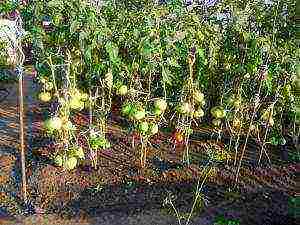
Containers with plants must be placed slightly above ground level.
After two weeks, the emerging seedlings can be transplanted to a permanent place, in prepared containers or bags.
Containers with plants must be located just above the ground level, then pests and other damage are not afraid of tomato seedlings.
In a greenhouse, there should be no more than three plants per square meter, otherwise they will not have enough light.
In order to harvest Dutch tomatoes all year round in the greenhouse, pipes of the heating system are laid on top of it. Due to this, the temperature of the air and soil will be within 18 degrees above zero. Comfortable temperature conditions will help ensure the development of a strong root system and prevent shedding of flowers and ovaries. And the fruits of tomatoes will be large, rich in color.
In order to obtain a good harvest, it is also necessary to organize air exchange in the room where tomato sprouts develop. Greenhouse fans are ideal for this. A prerequisite for obtaining tasty fruits is air humidity, it should not be lower than fifty percent.
The use of carbon dioxide for better photosynthesis of plants is also the main component for obtaining a high yield.
Some varieties of tomatoes from Holland can also be planted outdoors. But for this, it is advisable to process the seeds before planting, protecting them from viral and fungal attacks in the future. Overnight, the seeds are soaked in a solution of wood ash, or sodium humanate, or nitrophoska. After that, the seed is placed in clean water, and after rinsing for two days - in the refrigerator. Having undergone such treatment, the plants will be resistant to both diseases and small drops in air temperature.
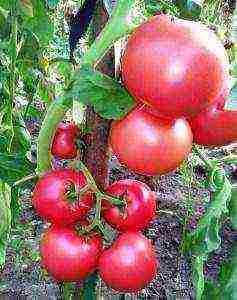
After the threat of frost passes, the prepared tomato seedlings are planted in open ground
After the threat of frost passes, the prepared tomato seedlings are planted in open ground. This should be done with special attention so as not to damage the root system of young plants. The roots with lumps of soil are carefully placed in the holes so that the leaves are above the ground at a distance of at least two centimeters, then the tomato stems will not come into contact with the ground and avoid the possibility of infection.
Creation of special conditions for Dutch varieties of tomatoes will increase the yield of the vegetable throughout the year.
Observe the rules of caring for tomatoes - the basis of a rich harvest
Gardeners-practitioners believe that the main condition for the correct development of tomatoes is the choice of the best option for watering tomato bushes. Drip irrigation of the plant from below is the most effective method of irrigation. For this, plastic pipes with special perforations are laid along the grooves, to which a watering hose is easily attached.
But the irrigation calendar depends on many conditions: on the ambient temperature, the rate of evaporation of moisture from the soil surface and solar activity. The water needed for watering a tomato is taken either from rainwater or at room temperature.
At the very beginning, it is advisable to drink the transplanted tomato seedlings with salt water in order to slightly increase the electrical conductivity of the plants.
Pruning excess flowers on the bush is also necessary for the active growth of the tomato. They usually leave five flowers on the first two brushes, and six on the others. Pollinating with the help of insects, you can achieve an increase in the number of fruits from the bush. If it is not possible to carry out such pollination, then you can simply shake a brush with flowers in the greenhouse, and then air the greenhouse.
It is imperative to form a bush in tomato hybrids, preventing stepsons from developing and leaving the main stem. This usually applies to indeterminate types of tomato, the stem of which can grow indefinitely. And you can't do without tying to stakes or on trellises. But determinant tomatoes stop growing in length after five flower brushes begin to tie. Therefore, they do not need any pinching or tying when growing in greenhouses. But for species growing in the garden, you will have to carry out a garter, otherwise the stem will not support the weight of a large number of fruits.
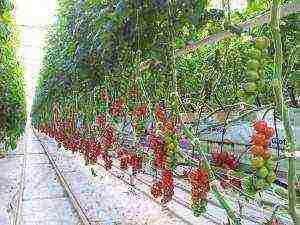
Removing stepchildren is a crucial moment in caring for tomatoes
Removing stepchildren is a crucial moment in caring for tomatoes. Leaving a few stems on the plant produces more fruits, but they will be small and of poor quality in size. With a warm, dry summer, up to three stems are left at the vegetable, and with hot and humid ones - no more than two.
Dutch breeders pay great attention to plant feeding without applying it to the root, because through the leaves the necessary substances will be absorbed faster by the vegetable. Once a week, it is necessary to spray the tomato bushes with a solution of magnesium or boron.
With a lack of calcium in the soil, the fruits will begin to rot and ripen unevenly. Then spraying with a filtered solution of wood ash will come in handy.
To speed up the ripening process of fruits, it is necessary to remove the leaves above them in order to avoid shading.
Scientists recommend to paint the stems of the remaining tomatoes with a special hormone, ethylene, ten days before the end of the harvest. It will help the fruit ripen quickly.
Once the tomatoes are ripe, harvest begins four times a week in the morning. In winter, tomatoes in greenhouses will look less ripe, but it will already be possible to pluck them from the bush. In order for them to mature, they must be placed in a dark room with a high air temperature.
After all the fruits are harvested, it is necessary to carry out a general cleaning in the greenhouse, removing all old, dry bushes and processing the soil. Then it is possible to start sowing anew to grow the next batch of tomatoes.
While watching the video, you will learn about caring for tomatoes.
When choosing Dutch tomato seeds, many gardeners choose to guarantee quality and a good harvest. The market is replete with varieties of Dutch selection, which allows you to choose the type of tomato that is characterized by a high yield percentage, fruit strength, the ability to withstand transportation, adapt to growing conditions and excellent taste.
Have you noticed a mistake? Select it and press Ctrl + Enter to tell us.
A tomato
